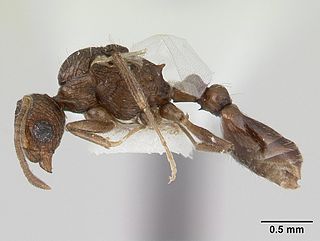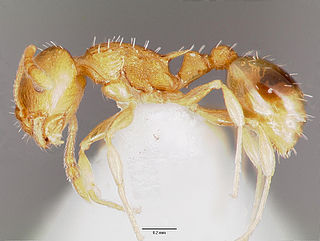
Temnothorax brunneus is a species of ant in genus Temnothorax, that can be found in Algeria and Morocco.
Temnothorax kutteri is a species of ant in the genus Temnothorax. It is native to southern France and eastern Iberia, from the Pyrenees to the Sierra Nevada. The species parasitises other ant species in the genus Temnothorax.

Temnothorax muellerianus is a species of ant in the genus Temnothorax.
Temnothorax sentosus is a species of ant in the genus Temnothorax, that is native to Kazakhstan.
Temnothorax tarbinskii is a species of ant in the genus Temnothorax, that is native to Kyrgyzstan.
Temnothorax inquilinus is a species of ant in the genus Temnothorax native to Ukraine.
Temnothorax tramieri is a species of ant in the genus Temnothorax, that is native to Morocco.

Leptothorax recedens is a species of ant in the family Formicidae. It is found in France, Italy, and Spain, with the most recent finding in Slovenia.

Temnothorax americanus is a species of slave-maker ant in the genus Temnothorax. The ants are 2–3 mm in size, and endemic to the northeastern United States and adjacent Canadian regions. They do not forage for food, but instead 'scout workers' from the colony seek out nearby host colonies of ants, steal larvae and bring them back to their own colony. A small T. americanus colony could consist of a queen, two to five workers and thirty to sixty slaves.

Temnothorax albipennis, the rock ant is a species of small ant in the subfamily Myrmicinae. It occurs in Europe and builds simple nests in rock crevices.

Temnothorax unifasciatus is a species of ant in the subfamily Myrmicinae.

Temnothorax is a genus of ants in the subfamily Myrmicinae. It contains more than 350 species.
Temnothorax pilagens is a small Nearctic species of slave-making ant in the subfamily Myrmicinae. It occurs in northeastern United States. It raids the acorn castles of other insects and captures them as slaves and has been nicknamed the pillage ant.

Temnothorax nylanderi is a species of ant in the genus Temnothorax. The species is found in western Europe. It was first described by Förster (1850) based on a male from Germany.

Temnothorax curvispinosus is a species of ant in the genus Temnothorax. The species is common and widely distributed in eastern United States, where they inhabit forested areas. They build their nests in plant cavities, in the soil or under rocks.

Temnothorax rugatulus is a species of ant in the genus Temnothorax. It is found in North America. More specifically, it is found in the forests of the western United States. Colonies are either monogynous or polygynous. Queens in monogynous colonies are generally larger (marcogynes), about twice the size of conspecific workers; polygynous colonies have smaller queens (microgynes), typically slightly smaller than the workers. T. rugatulus ants are a subdominant ant group.

Temnothorax gallae is a species of ant in the family Formicidae.
Nigel R. Franks is an English emeritus professor of Animal Behaviour and Ecology at the University of Bristol. He obtained a BSc and PhD in biology at the University of Leeds. After receiving his BSc in 1977 he began his PhD, during which he spent two years doing field work in Panama on army ants with the Smithsonian Tropical Research Institute. He was awarded the Thomas Henry Huxley Award in 1980 from the Zoological Society of London for the best British PhD in Zoology. He then received a Postdoctoral Fellowship from the Royal Commission for the Great Exhibition of 1851 allowing him to undertake postdoctoral work under Edward O. Wilson at Harvard University before becoming a lecturer at the University of Bath in 1982, later being promoted to full professor in 1995. He moved to the University of Bristol in 2001. He is renowned for his studies of collective animal behaviour, particularly of ant colonies. His Ant Lab at Bristol pioneered the use of Temnothorax as a model ant species for the study of collective decision-making and complex systems. In a 2009 profile in Science he discusses his pioneering use of radio-frequency identification tags (RFID) glued to the backs of each ant for tracking individuals in their society. His book Social evolution in ants with Andrew Bourke was an important contribution to the understanding of kin selection theory and sex ratio theory with respect to social evolution in insects, while his co-authored book Self-organization in biological systems has been cited well over 3000 times
Temnothorax lichtensteini is a Mediterranean species of ant in the genus Temnothorax.











